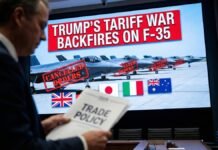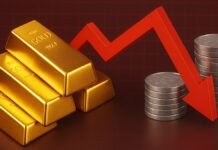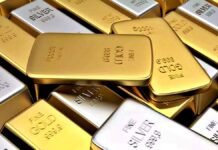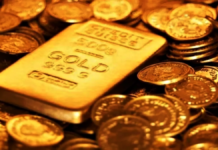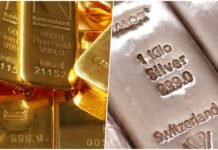
Key Points
- Gold prices showed modest consolidation on November 27, 2025, after climbing steadily over the previous three sessions
- 24-carat gold is trading at ₹127,920 per 10 grams in major cities, down ₹470 from the previous close
- 22-carat gold stands at ₹115,390 per 10 grams, reflecting a 0.37% decline
- Wedding season demand continues to be a primary driver of gold purchases across India
- Federal Reserve officials have signaled a potential 0.25% interest rate cut in December 2025
- Market participants are pricing in an 85% probability of a December Fed rate cut
- Gold prices in India remain 11.58% more expensive than Dubai prices
- Silver prices in India are at ₹167-173 per gram, showing volatility and trading opportunities
- Global gold futures traded near $4,158 per ounce, supported by rate-cut expectations
- Robert Kiyosaki predicts silver could reach $200 per ounce by 2026
- November 2025 has seen gold prices range between ₹119,632 and ₹127,651 per 10 grams
Gold prices in India experienced a brief consolidation phase on November 27, 2025, after delivering strong gains during the previous three trading sessions. The national average price for 24-carat gold eased to ₹12,775 per gram, translating to ₹127,750 per 10 grams, representing a decline of ₹470 or 0.37% from the previous close. This modest pullback reflects routine market adjustment and profit-booking activity rather than a fundamental shift in sentiment, according to market analysts.
However, the broader trend remains distinctly upward compared to levels observed earlier in the month. On November 23, 2025, 24-carat gold was trading at ₹12,584 per gram, meaning prices have accumulated a net gain of approximately ₹191 per gram, or 1.52%, over just four trading days. This recovery underscores the underlying strength in bullion markets despite the recent consolidation phase.
City-Wise Price Variations on November 27
Across major Indian cities, gold prices displayed uniform weakness on November 27, with minimal regional variations reflecting the centralized nature of India’s precious metals pricing mechanism. In Mumbai, Hyderabad, and Kerala, 24-carat gold was quoted at ₹12,775 per gram, aligning closely with the nationwide trend. Chennai continued to trade at a marginal premium with prices at ₹12,840 per gram, while Bangalore matched the broader levels at ₹12,775 per gram.
Delhi held steady near the upper band at ₹12,790 per gram, supported by stable local demand dynamics ahead of the wedding season. For 22-carat gold, the national average was ₹11,710 per gram on November 27, with 18-carat gold trading at ₹9,581 per gram.
Gold Price Comparison: India vs. Global Markets
A significant pricing disparity exists between Indian and international gold markets, with India commanding a notable premium over global benchmarks. On November 27, 2025, 24-carat gold in India was priced at ₹125,880 per 10 grams, while the same purity gold in Dubai was available at ₹112,816 per 10 grams. This difference of ₹13,064 per 10 grams, representing an 11.58% premium in India’s favor, is attributed to import duties, local taxes, and retail markups that do not apply in duty-free trading zones like Dubai.
Similarly, 22-carat and 18-carat gold prices in India were also approximately 11.58% costlier compared to Dubai market rates. This gap reflects India’s significant import duties and the domestic taxation structure applied to precious metals, making it economically viable for some high-volume buyers to source gold from international markets despite logistics complexities.
Federal Reserve Policy Signals Driving Global Gold Rally
The primary catalyst propelling gold prices higher in recent weeks has been dovish commentary from United States Federal Reserve officials regarding potential interest rate reductions. Federal Reserve Board member Christopher Waller indicated that the labor market is showing signs of weakness, making a 0.25% interest rate cut possible in December 2025. This comment reignited investor expectations for monetary easing after several months of rate hold signals.
Market participants have dramatically repriced their expectations following these policy signals. According to CME FedWatch Tool data, traders are now assigning nearly an 85% probability to a December rate cut, a significant increase from just 40% probability levels recorded a week earlier. When interest rates fall, the opportunity cost of holding non-yielding assets like gold diminishes substantially, making bullion more attractive to both institutional investors and retail participants.
Global Gold Futures Performance
U.S. gold futures have responded robustly to these rate-cut expectations, trading near $4,158 per ounce as of late November 2025. Gold futures for December delivery have climbed 0.4% to $4,157.90 per ounce in recent trading, extending gains from the previous week. This movement reflects both rate-sensitive demand and renewed hedging interest ahead of the December Federal Reserve policy meeting.
The broader macroeconomic backdrop has provided additional support to gold prices. Delayed U.S. economic releases, including September retail sales, jobless claims, and producer price statistics, showed modest performance, reinforcing the narrative that economic activity is moderating without collapsing. These data points have reduced the urgency for restrictive monetary policy and contributed to the case for easing, with markets now interpreting policy expectations as moving toward looser financial conditions.
Wedding Season Demand Sustains Domestic Gold Appetite
The onset of India’s festive wedding season has emerged as a critical demand driver for gold and silver across the country. Wedding season purchasing traditionally spans November through early December, coinciding with auspicious dates in the Hindu calendar and the commencement of major celebrations nationwide.
During this period, demand for gold jewelry, coins, and bars typically surges significantly above baseline levels, with retailers and online platforms reporting increased traffic and transaction volumes. Many Indian families view gold purchase during the wedding season as both an essential ceremonial requirement and a long-term store of value, combining cultural traditions with investment considerations. This dual motivation creates particularly robust demand that can absorb price increases without significantly dampening sales volumes.
Market analysts note that wedding season demand has been particularly strong in 2025, with jewelers reporting improved footfall compared to the same period in 2024. This resurgence follows a period of subdued demand in late 2024, and reflects improving consumer confidence and disposable income levels among India’s middle and upper-middle classes.
Silver Market Dynamics and Volatility Opportunities
Silver prices in India displayed greater volatility compared to gold on November 27, 2025, adding both complexity and opportunity for traders and investors. The price of silver in India stood at ₹167-173 per gram, representing moderate fluctuations from previous trading sessions. On a per-kilogram basis, silver was trading at ₹167,000 to ₹173,000.
Silver’s higher volatility profile compared to gold reflects its dual nature as both a precious metal store of value and an industrial commodity with significant demand from electronics, solar panel manufacturing, and pharmaceutical applications. These competing demand dynamics create more pronounced price swings than observed in gold markets, where investment demand dominates.
Silver as an Investment Hedge
Despite its volatility, silver continues attracting investor attention as an inflation hedge and portfolio diversification tool. The white metal remains a compelling choice for investors seeking exposure to precious metals with lower entry prices than gold, allowing broader participation across income levels. Silver’s higher volatility can be both advantageous for skilled traders seeking short-term trading opportunities and risky for conservative buy-and-hold investors seeking stable value preservation.
Expert Outlook: Silver Price Prediction by Robert Kiyosaki
Renowned author and investor Robert Kiyosaki has made a bullish long-term prediction regarding silver prices, suggesting that the precious metal could appreciate to $200 per ounce by 2026. Kiyosaki, best known for his bestselling book “Rich Dad, Poor Dad,” has long been an advocate for precious metals as essential portfolio components in uncertain macroeconomic environments.
This prediction, if accurate, would represent a substantial appreciation from current global silver prices hovering in the $50-52 per ounce range. Such a move would require either significant monetary debasement, acute supply disruptions, or a fundamental shift in investor risk sentiment toward precious metals. Kiyosaki’s bullish stance reflects growing concerns about fiat currency stability, unsustainable government debt levels, and potential stagflation scenarios in developed economies.
Price Movements Over Recent Trading Sessions
Gold prices have demonstrated significant momentum over the past several trading days, with November 2025 showing varied market conditions. The highest gold price recorded in November 2025 was ₹127,651 per 10 grams, while the lowest price was ₹119,632 per 10 grams, representing a range of ₹8,019 or approximately 6.7%. This volatility range reflects the dynamic interplay between domestic demand factors, international price signals, and policy expectations.
Price Comparison Across Recent Days
The trajectory of gold prices reveals strong upward momentum interrupted by periodic consolidation:
- November 24, 2025: 24K at ₹12,513 per gram, 22K at ₹11,470, 18K at ₹9,385
- November 25, 2025: 24K at ₹12,791 per gram, 22K at ₹11,725, 18K at ₹9,561
- November 26, 2025: 24K at ₹12,791 per gram, 22K at ₹11,725, 18K at ₹9,561
- November 27, 2025: 24K at ₹12,775 per gram, 22K at ₹11,710, 18K at ₹9,581
This pattern demonstrates that while gold retreated modestly on November 27, the net gain over the previous four days remains substantial, suggesting underlying strength.
Complete Gold Price Reference Table by City (November 27, 2025)
| City | 22-Carat Price (₹) | 24-Carat Price (₹) | Weight |
|---|---|---|---|
| Delhi | 115,390-117,410 | 125,880-128,070 | 10 grams |
| Mumbai | 115,390 | 127,920 | 10 grams |
| Bangalore | 115,390 | 127,750 | 10 grams |
| Chennai | 115,390 | 127,920 | 10 grams |
| Kolkata | 115,390 | 127,920 | 10 grams |
| Hyderabad | 115,390 | 127,920 | 10 grams |
| Jaipur | 115,410 | 128,070 | 10 grams |
| Bhopal | 115,310 | 127,970 | 10 grams |
| Lucknow | 115,410 | 128,070 | 10 grams |
| Chandigarh | 115,410 | 128,070 | 10 grams |
| Ahmedabad | 115,310 | 127,970 | 10 grams |
Market Outlook: Factors to Watch in December 2025
Several key developments will likely shape gold and silver price movements in December 2025, requiring close market attention from investors and traders. The December Federal Reserve policy meeting stands as the critical event, where officials will decide whether to execute the anticipated 0.25% rate cut or maintain current policy stance. If rate cuts are implemented as currently priced by markets, additional tailwinds could support gold prices. Conversely, if the Fed opts to hold rates steady, the 85% probability discount in rate-cut expectations could rapidly unwind, creating sharp downside pressure on bullion.
Beyond the Fed decision, investors should monitor upcoming U.S. labor market data, inflation reports, and revised economic growth estimates scheduled for December release. Additionally, the incoming Federal Reserve chairperson’s policy orientation will influence market sentiment regarding the trajectory of monetary policy in 2026 and beyond. Reports suggesting Kevin Hassett as a leading candidate for Fed chair have been interpreted favorably for pro-growth, accommodative policy preferences, providing additional support to rate-cut expectations.
Wedding Season Extension Into December
The continuation of India’s wedding season into early December will likely sustain elevated domestic gold demand through the initial weeks of the month. After this peak demand period concludes, gold prices may experience normalization unless international factors provide additional support. Investors planning to purchase gold or silver should carefully monitor both global policy signals and local festival calendars to optimize entry points.
Investment Considerations for Precious Metals
For investors considering precious metals exposure, the current environment presents both opportunities and risks. Gold’s historical role as an inflation hedge and portfolio diversifier remains intact, with valuations supported by dovish central bank policies globally. However, valuations at current levels have already incorporated substantial portions of the anticipated rate-cut cycle, potentially limiting further upside unless conditions deteriorate significantly more than currently expected.
Silver presents a more volatile but potentially rewarding option for investors with appropriate risk tolerance and time horizons. The white metal’s dual role as both precious metal and industrial commodity means price movements can be influenced by either precious metals demand or manufacturing activity cycles. For conservative investors prioritizing capital preservation, gold remains preferable, while aggressive traders may find silver’s volatility attractive.








